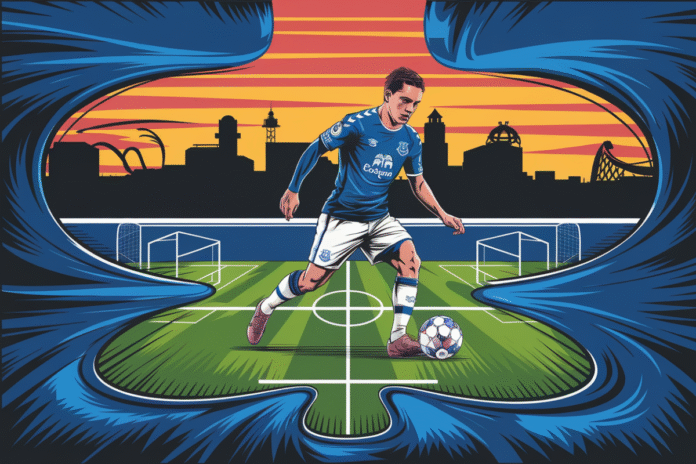“The iconic club crest has been replaced.” This bold statement signifies a dramatic shift in the identity of a beloved football club. Everton’s decision to forgo its traditional emblem in favor of a pentagon symbol inspired by Prince Rupert’s Tower has sent shockwaves through the football community. The new design not only marks a departure from the club’s historical branding but also invites a broader conversation about the evolution of sports team identities in the modern era. As clubs strive to balance tradition with innovation, how far can they push the boundaries of their visual representation?
The stakes are high for Everton as they unveil this unconventional third kit for the 2025/26 season. Fans are left to grapple with mixed emotions, torn between nostalgia for the familiar crest and curiosity about the new design. This transformation reflects a broader trend in sports, where teams increasingly seek to redefine themselves in a competitive market. Will this change resonate positively with supporters, or will it lead to backlash from those who cherish the club’s heritage? The implications of this decision extend beyond aesthetics, potentially influencing the club’s brand identity, merchandise sales, and fan engagement.
A Bold New Identity
The choice to replace a traditional club crest with a pentagon symbol is not merely a design alteration; it represents a fundamental shift in how Everton wishes to be perceived. The pentagon, inspired by Prince Rupert’s Tower, serves as a nod to the club’s historical roots while simultaneously embracing modern design elements. This new identity aims to capture the essence of Everton’s legacy while appealing to a younger, more diverse fan base.
Historically, sports team logos have served as powerful symbols of community and pride. By adopting a more abstract design, Everton is stepping into uncharted territory, challenging the conventions that have long defined football club branding. This move is reflective of a wider trend in sports, where teams are experimenting with their visual identities to stand out in an increasingly crowded marketplace.
The implications of this decision could be significant. A successful rebranding could enhance Everton’s appeal, attracting new fans and increasing merchandise sales. Conversely, if the new design fails to resonate, it could alienate loyal supporters who feel disconnected from the club’s new direction. As the football landscape continues to evolve, the importance of a strong visual identity cannot be overstated.
Fan Reactions and Cultural Impact
The unveiling of the new kit has sparked a variety of reactions from fans and critics alike. Some supporters have embraced the change, viewing it as a fresh start and an opportunity to redefine the club’s image. Others, however, express concerns about losing the historical significance attached to the traditional crest. This divide highlights the complex relationship between fans and their clubs, particularly when it comes to matters of identity.
Social media has played a crucial role in shaping the discourse around the new design. Supporters have taken to platforms like Twitter and Instagram to voice their opinions, creating a vibrant dialogue about the implications of this change. Memes, artwork, and commentary have flooded timelines, showcasing the passionate engagement of the fan base. This cultural phenomenon underscores the importance of fan sentiment in the decision-making processes of sports organizations.
The potential cultural impact of this rebranding extends beyond the immediate fan base. As Everton positions itself as a forward-thinking club, it may influence other teams to reconsider their own identities. This could lead to a broader trend within the sport, where clubs prioritize modernity and innovation over tradition. The evolution of football branding is an ongoing narrative, and Everton’s bold move could serve as a catalyst for change within the industry.
Commercial Implications and Market Positioning
The commercial landscape of sports is fiercely competitive, and Everton’s new kit design may play a pivotal role in its market positioning. By adopting a unique visual identity, the club aims to differentiate itself from rivals, potentially attracting new sponsorships and partnerships. The pentagon symbol of Prince Rupert’s Tower could appeal to brands seeking to align with a club that embodies both tradition and modernity.
Merchandise sales are a critical revenue stream for football clubs, and the success of the new kit will largely depend on fan acceptance. If the design is well-received, it could lead to a significant boost in sales, providing essential funding for the club’s operations and player acquisitions. Conversely, a negative reception could hinder these financial opportunities, emphasizing the importance of aligning branding with fan expectations.
As Everton navigates this new chapter, it will need to carefully monitor market trends and fan sentiments. Understanding the balance between innovation and tradition will be crucial in maintaining a strong brand identity. The club’s ability to adapt to changing consumer preferences will ultimately determine its success in the competitive landscape of professional football.
The Future of Football Branding
Everton’s decision to replace its traditional crest with a new pentagon symbol raises important questions about the future of football branding. As clubs increasingly seek to modernize their identities, the line between tradition and innovation becomes blurred. This evolution presents both challenges and opportunities for teams as they attempt to connect with diverse audiences.
The trend toward rebranding is not limited to Everton; many clubs are exploring new visual identities to resonate with younger fans. This shift reflects broader societal changes, where authenticity and relatability are paramount. Clubs that can effectively communicate their values through design will likely thrive in this evolving landscape.
As the football industry continues to adapt, the significance of a strong brand identity cannot be overstated. Everton’s bold move may inspire other clubs to rethink their own branding strategies, leading to a dynamic transformation within the sport. The future of football branding is poised for exciting developments, and Everton’s journey will be closely watched as a potential blueprint for success.


